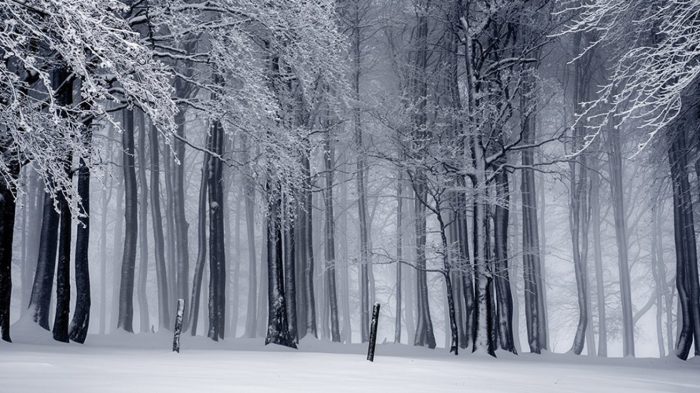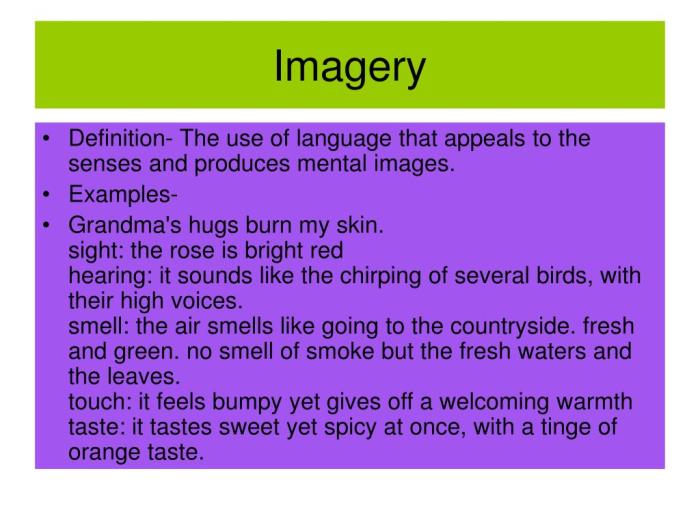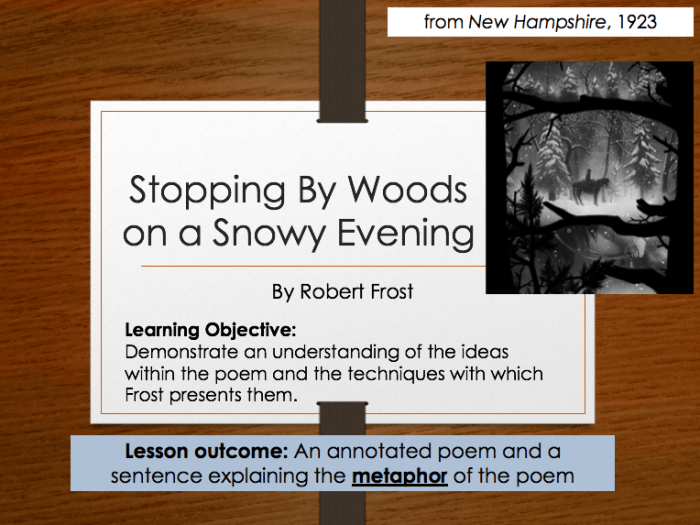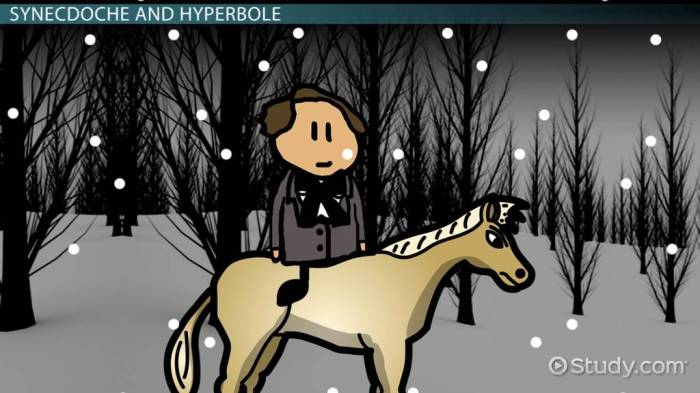Stopping by woods on a snowy evening figurative language – Robert Frost’s “Stopping by Woods on a Snowy Evening” is a profound and evocative poem that employs a rich tapestry of figurative language to explore themes of solitude, nature, and the human condition. Through metaphors, personification, and sound devices, Frost creates a vivid and immersive experience, inviting readers to contemplate the complexities of human existence.
The poem’s central metaphor, the “woods,” symbolizes the unknown or the subconscious, while the act of “stopping” represents a pause for reflection. Frost’s use of personification, such as the “easy wind” and the “dark and deep” woods, imbues the natural world with human qualities, enhancing the poem’s emotional resonance.
Metaphorical Language
The poem’s use of metaphorical language is essential to its meaning. The “woods” symbolize the unknown or the subconscious, a place where the speaker can escape the familiar and explore his inner thoughts and emotions. The act of “stopping” represents a pause or a moment of reflection, a chance to consider the speaker’s place in the world.
The “Easy Wind”
The “easy wind” is a metaphor for the speaker’s own thoughts and feelings. It is “easy” because it flows naturally and effortlessly, but it is also “wind,” something that is intangible and elusive. This suggests that the speaker’s thoughts and feelings are both free and fleeting.
Personification and Imagery: Stopping By Woods On A Snowy Evening Figurative Language

Personification
The poem uses personification to give human qualities to non-human things. For example, the “woods” are said to “fill up with snow,” as if they were a living being. This personification helps to create a sense of intimacy between the speaker and the natural world.
Sensory Imagery
The poem also uses sensory imagery to create a vivid and immersive experience. The speaker describes the “sound of his own axe against the cold” and the “smell of the snow.” These sensory details help the reader to feel as if they are actually there with the speaker in the woods.
Symbolism of the “Dark and Deep” Woods
The “dark and deep” woods symbolize the unknown and the mysterious. They are a place where the speaker can lose himself and explore his inner thoughts and emotions. The darkness and depth of the woods also suggest that the speaker is on a journey of self-discovery.
Sound Devices

Alliteration and Assonance
The poem uses alliteration and assonance to create a sense of rhythm and flow. For example, the lines “Whose woods these are I think I know” and “He will not see me stopping here” use alliteration to create a sense of rhythm.
The lines “And miles to go before I sleep” and “The woods are lovely, dark and deep” use assonance to create a sense of flow.
The “Sound of His Own Axe”
The “sound of his own axe” is a recurring sound in the poem. It represents the speaker’s own thoughts and feelings. The sound of the axe is both comforting and unsettling, as it reminds the speaker of his own mortality and the passage of time.
Irony and Ambiguity

Irony
There is a sense of irony in the speaker’s desire to “watch his woods fill up with snow.” This suggests that the speaker is aware of the impermanence of life and the inevitability of death.
Ambiguity
The poem’s ending is ambiguous. The speaker says that he will “keep his appointment in the village,” but it is unclear what this appointment is. This ambiguity suggests that the poem is about more than just a simple walk in the woods.
It is about the speaker’s journey of self-discovery and his search for meaning in life.
Tension between Solitude and Responsibility
The poem explores the tension between the speaker’s desire for solitude and his recognition of his obligations to others. The speaker wants to stay in the woods and explore his inner thoughts and emotions, but he also knows that he has responsibilities to his family and community.
This tension is a common theme in literature, and it is one that many people can relate to.
Structure and Form
Four-Stanza Structure
The poem is written in a unique four-stanza structure. The first stanza introduces the setting and the speaker’s desire to stay in the woods. The second stanza describes the woods in more detail and introduces the sound of the speaker’s own axe.
The third stanza explores the speaker’s thoughts and feelings about his own mortality and the passage of time. The fourth stanza concludes the poem with the speaker’s decision to keep his appointment in the village.
Enjambment and Caesura
The poem uses enjambment and caesura to create a sense of rhythm and flow. Enjambment is the continuation of a sentence from one line to the next. Caesura is a pause in the middle of a line. Both of these techniques help to create a sense of movement and energy in the poem.
Rhyme Scheme and Meter
The poem uses a rhyme scheme of ABAB CDCD EFEF GG. The meter is iambic tetrameter, which means that each line has four iambs. An iamb is a metrical foot consisting of an unstressed syllable followed by a stressed syllable.
Theme and Interpretation

Central Theme
The central theme of the poem is the human experience, particularly in relation to nature and the passage of time. The poem explores the speaker’s desire for solitude and his recognition of his obligations to others. It also explores the speaker’s thoughts and feelings about his own mortality and the inevitability of death.
Exploration of the Human Experience, Stopping by woods on a snowy evening figurative language
The poem is a meditation on the human experience. It explores the speaker’s thoughts and feelings about life, death, and the passage of time. The poem is also a celebration of the beauty of nature and the importance of solitude.
Message about Solitude and Responsibility
The poem’s message is that it is important to embrace both solitude and responsibility. The speaker needs solitude to explore his inner thoughts and emotions, but he also knows that he has responsibilities to his family and community. The poem suggests that it is possible to find a balance between the two.
Commonly Asked Questions
What is the significance of the “woods” in the poem?
The “woods” symbolize the unknown or the subconscious, representing the speaker’s inner thoughts and emotions.
How does Frost use personification in the poem?
Frost personifies the wind and the woods, giving them human qualities to enhance the poem’s emotional impact.
What is the irony in the speaker’s desire to “watch his woods fill up with snow”?
The irony lies in the speaker’s desire to witness the beauty of nature while acknowledging that his presence will disturb its tranquility.